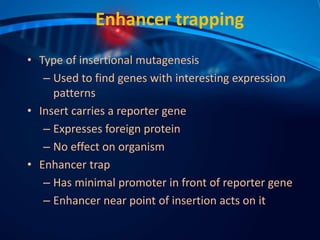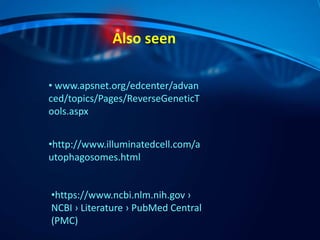Forward and reverse genetics
- 1. Jawaharlal Nehru Krishi VishwaVidyalaya, Jabalpur (2016-17) Credit seminar on Guided by- Dr. D.K. MISHRA Submitted by- Srishti Singh Roll no 6527 M.Sc. (Ag) final year
- 3. GENETICS •Science that deals with the structure,organisation,transmission and function of genes, and the origin of variation •Founder -Mendal in 1866 •Terms given by-Bateson in 1905 By:Wikipedia
- 4. Background •Genetics is the study of gene function •Gene function is inferred from the resulting phenotype when the gene is mutated •Genomics is changing the way of genetics is performed Globally,i.e. high-throughput approaches •Genomics approaches are being applied to both forward and reverse genetics GENETICS FORWARD GENETICS REVERSE GENETICS
- 5. Forward Genetics Forward genetics starts with identification of interesting mutant phenotype
- 6. AIM Then aims to discover the function of genes defective in mutants by chromosome walking chromosome contig candidate genes mutation To find all of the genes involved in a trait
- 7. •Forward genetics usually starts with mutagenesis of organism Can use chemicals e.g., ethyl methyl sulfonate Or can use radiation e.g., X rays, gamma rays •Then screen progeny of mutagenized individuals for phenotypes of interest BASICS OF FORWARD GENETICS
- 8. Visually- abnormal morphology, growth rate, color, flowering, fertility, etc. Biochemically— alterations in basic cell processes (replication, protein synthesis, etc.) Microscopically (use fluorescent tags to see overexpression) and image analysis How do scientists screen phenotypes? http://www.illuminatedcell.com/autophagosomes.html
- 9. Genetic analysis First step in analysis of mutants: • Precisely describe phenotype Basis of predicting gene function: •identify precisely what has malfunctioned (wrong) in the mutant •That is what the gene product does in the wild type
- 10. STEPS IN FORWARD GENETICS A set of mutants lines are created either by EMS and/or TDNA / transposon preferably called as knockout for the latter. These mutant lines are then screened for a particular phenotype usin g mutant screens or procedures where a large number of mutants can be screened in a bulk manner The selected mutants are then carried forward and analyzed by PCR (i n case of TDNA insertion lines), backcrossed to remove or dilute any unwanted insertions of TDNA
- 11. The next logical steps involves cloning of the full length gene an d cDNA from the wild type plants. In the final validation step, the gene isolated in the previous step is use d to transform the mutant plant and phenotyped. “If Themutant plant exhibits recovery of wild type phenotype, it is assume d that the wt type gene is able to rescue the mutant; hence this validates the gene function.” The sequence information generated from the PCR is then used to ident ify the gene where the insertion has taken place and this becomes the candidate gene for the phenotype tested in previous steps.
- 12. Genomics and forward genetics High-throughput genetic screens •Candidate-gene approach To go from phenotype to gene •Insertional mutagenesis Loss-of-function mutation Activation tagging •Enhancer trapping
- 13. High-throughput genetic screen Paradigm Genetics, Inc. performs “phenotypic profiling” Take measurements of mutants’ physical and chemical parameters e.g., plant height, leaf size, root density, and nutrient utilization Different developmental times: compare to wild type
- 14. From phenotype to gene Once an interesting mutant is found and characterized, we want to find the gene in which the mutant occurred Positional cloning •First use genetic mapping •Then use chromosome walking chromosome contig candidate genes mutation
- 15. Candidate-gene approach If the mutated gene is localized to a sequenced region of the chromosome, then look for genes that could be involved in the process under study Last step: •confirm gene identification •Rescue of phenotype •Mutations in same gene in different alleles
- 16. Insertional mutagenesis •Alternative to chromosome walking •To reduce time and effort required to identify mutant gene •Insert piece of DNA that disrupts genes •Inserts randomly in chromosomes •Make collection of individuals •Each with insertion in different place •Screen collection for phenotypes •Use inserted DNA to identify mutated gene :Researchgate
- 17. Insertional mutagenesis in Arabidopsis • T-DNA inserts into plant chromosome • Screen for mutations that affect flower formation • Make genomic library from mutant DNA • Probe with T-DNA • Identify mutant gene T-DNA inserts into gene probe library made from T-DNA tagged mutant with T-DNA sequence DNA flanking T-DNA to identify gene
- 18. Enhancer trapping • Type of insertional mutagenesis – Used to find genes with interesting expression patterns • Insert carries a reporter gene – Expresses foreign protein – No effect on organism • Enhancer trap – Has minimal promoter in front of reporter gene – Enhancer near point of insertion acts on it
- 19. Enhancer trapping in Drosophila • Use transposon P element • Carries reporter gene – b-galactosidase • Hops into genome • When lands near enhancer, activates gene expression • Expression similar to that of neighboring gene P element recognition sites enhancer gene Y enhancer b-galactosidase b-galactosidase gene Y
- 20. Advantages and disadvantages of Forward genetics It is a tested method and many genes have been isolated in plants. It works very well in phenotypes that can be distinguished quickly, for eg. color, shape etc. It works in a unbiased manner because it is random in natureThe mutant lines created are quite stable and T- DNA is known to preferentially integrate in and around the genic region On the other hand, phenotypes that are difficult to evaluate mak e it very tedious. Only one gene/trait can be analyzed Some genes may be missed and the procedure works only in plan ts that are amenable to Agrobacterium transformation
- 21. REVERSE GENETICS Reverse genetics starts with a known gene and alters its function by transgenic technology
- 22. AIM Then aims to determine the role of the gene from the effects on the organism AGCTCAATAGATAATC TCGAGTTAGTCTATTAG Sequence/mutation DNA Phenotype
- 23. Basics of reverse genetics To find out the function of a known gene • Reverse genetics starts with known genes – e.g., from genomic sequencing • to determine function through targeted modulation of gene activity Decrease Increase
- 24. Reverse Genetics Techniques Virus indused gene silencing Chemical mutagenesis or TILLING RNA mediated interfernce (RNAi) DELETEAGENES
- 25. Virus indused gene silencing(VIGS) eg: zebra fish Injection of zebra fish embryo with retrovirus preparation Raising of founder embryo generation F1 generation by inbreeding/outbreeding of founder Identification of F1 fish with multiple insertions
- 26. Raising F2 families by inbreeding selected F1 fishes Sperms were collected and archived from 2nd and 3rd generation DNA extracted from fin clips Insertion sites were identified by LM-PCR and sequencing Eg. Arabidopsis
- 28. RNA mediated interfernce (RNAi) •Suppresses gene expression •Post-transcriptional biological process •mRNA degradation/ inhibition of translation •Target - dsRNA
- 29. The Mechanism of RNA Interference
- 30. DELETEAGENES useful for small genes and tandem repeats Deletion library construction Treat wild type seeds with fast neutron Plant M1 seeds and grow up population Collect M2 seeds from individual plants Plant some seeds from each line Collect tissue and extract DNA Fast Neutron Deletion Mutagenesis-based Reverse Genetics Approach for Plants
- 31. TILLING is a general reverse genetic technique that combines chemical mutagenesis with PCR based screening to identify point mutations in regions of interest. (McCallum et.al, 2000) (Targeting Induced Local Lesions IN Genomes) TILLING TILLING first began in the late 1990’s by McCallum who worked on characterizing the function of two chromomethylase gene in Arabidopsis.
- 32. Development of mutagenized population EMS mutagenesis Development of M2 population DNA preparation and pooling of individuals Mutation Discovery PCR amplification of a region of interest Mismatched cleavage Detection of Heteroduplexes as extra peak or band (HPLC or Acrylamide gel) Identification of the mutant individual Sequencing of Mutant PCR product The TILLING Methodology
- 33. The TILLINGpopulation-MUTAGENESIS Mutagenizing seed with EMS done by soaking seeds in an EMS solution (14-18 h in a 30-100 mM (0.3%-1%) EMS solution.) Planting the seeds in field Mutagenized population (M1generation) is grown to maturity allowed to self-fertilize to produce M2 seeds. M2 seeds can be maintained as lines or bulked If the M2 seed is bulked then lines need to be established using M3 seed. In either case, when sampling M2 plants to establish population
- 34. Arraying the population for TILLING Genomic DNA is isolated from individuals M2/M3 plants Standardized the DNA concentration of each sample Arrayed in a 96-well microtiter plate Allowing up to 8-fold pooling of diploid plants to increase TILLING throughput
- 36. Advantages Its applicability to virtually any organism. Its facility for high-throughput and its independence of genome size, reproductive system or generation time. Since it uses Chemical mutagenesis virtually all genes can be targeted by screening few individuals. High degree of mutational saturation can be achieve without excessive collateral DNA damage. Eco- TILLING is useful for association mapping study and linkage disequilibrium analysis. Ecotilling can be used not only to determine the extent of variation but also to assay the level of heterozygosity within a gene.
- 37. EcoTILLING The first publication of the EcoTILLING method in which TILLING was modified to mine for natural polymorphisms was in 2004 from work in Arabidopsis thaliana. EcoTILLING is similar to TILLING, except that its objective is to identify natural genetic variation as opposed to induced mutations. Many species are not amenable to chemical mutagenesis; therefore, EcoTILLING can aid in the discovery of natural variants and their putative gene function This approach allows one to rapidly screen through many samples with a gene of interest to identify naturally occurring SNPs and / or small INs/DELS.
- 40. CASE STUDY Forward genetics in a reverse way
- 41. REFERENCES Azpiroz-Leehan, R., and Feldmann, K.A. (1997).T-DNA insertion mutagenesis in Arabidopsis: Going back and forth. Trends Genet. 13, 152–159. Bradelly J Till et al.,(.2004) Discovery of induced mutation in maize by TILLING:BMC Plant biology.4,471-2229 Krysan, P.J., Young, J.C., and Sussman, M.R. (1999). T-DNA as an insertional mutagen in Arabidopsis. Plant Cell 11, 2283–2290 Parinov, S., and Sundaresan, V. (2000). Functional genomics in Arabidopsis: Large-scale insertional mutagenesis complements the genome sequencing project. Curr. Opin. Biotechnol. 11, 157–161. Sussman, M.R., Amasino, R.M., Young, J.C., Krysan, P.J., and Austin- Phillips, S. (2000). The Arabidopsis knockout facility at the University of Wisconsin-Madison. Plant Physiol. 124, 1465–1467.










































